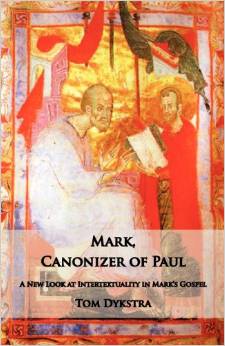 Until recently I have had little interest in arguments that our apparently earliest written gospel, the Gospel of Mark, was composed as an attempt to teach the ideas of Paul as found in his letters. After reading Mark, Canonizer of Paul by Tom Dykstra I am now more sympathetic to the possibility that the author of this gospel really was writing as a follower of Paul.
Until recently I have had little interest in arguments that our apparently earliest written gospel, the Gospel of Mark, was composed as an attempt to teach the ideas of Paul as found in his letters. After reading Mark, Canonizer of Paul by Tom Dykstra I am now more sympathetic to the possibility that the author of this gospel really was writing as a follower of Paul.
Dykstra introduces his argument by pointing out how curiously uninterested the author of the Gospel of Mark is in the contents of Jesus’ teachings. Jesus is said to teach with authority and crowds are said to be impressed with his teachings but exactly what he taught in the synagogues or to those who crowded around to hear him in a house is left unsaid. Jesus does teach a lot of parables warning hearers of the consequences of not believing the gospel but the content of that gospel, the detail of what they must believe, is never stated. About the only teaching Mark’s Jesus is said to have delivered is little more than “Keep the commandments”.
Then there is the curious ending: why does Mark virtually leave the resurrection details out of the story altogether?
Dykstra sums up his argument:
The explanation I offer in this book can be summarized as follows. Mark’s primary purpose was to defend the vision of Christianity championed by Paul the Apostle against his “Judaizing” opponents. He undertook this defense because epistles written in the Apostle’s name were no longer deemed adequate, possibly because Paul himself was no longer around to personally defend his authority. Mark didn’t report any new teachings of Jesus because none were available to him: his main sources were the Old Testament, the Homeric epics, and Paul’s epistles, not the disciples or oral tradition. And so he wrote a Gospel that implicitly validated the authority of Paul and his epistles. . . . My goal in this book is mainly to present the evidence for a literary relationship between Mark and Paul’s epistles. (p. 23, my bolding)
This situation makes sense, Dykstra suggests, if Paul had died and his teachings were in danger of being eclipsed by his opponents.
In chapter two and relying primarily upon Michael Goulder’s argument in St. Paul vs. St. Peter: A Tale of Two Missions Dykstra presents a scenario of a sharp divide between two different types of gospels. Goulder was reviving (and responding to criticisms of) an 1831 interpretation by Ferdinand Baur.
Peter’s mission believed that the heavenly kingdom had already arrived and believers were already enjoying the resurrected life, while Paul stressed that the resurrection was yet to come and believers’ present life was more like the crucifixion. . . . Peter’s mission stressed tongues and visions and gifts of the spirit, while Paul’s stressed love and charity; Peter’s mission stressed the need to give away all of one’s possessions since the end had already come, while Paul’s mission advised people to keep working and earning a living. As will be seen, some of these differences are reflected in the text of Mark’ Gospel. (p. 35)
If the evangelist wanted to create a narrative to bolster the embattled teachings and authority of Paul he would need to project a dispute of his own and Paul’s day back into that narrative. The narrative would also need to show that apostles who came prior to Paul, even those claiming to be his brothers and those who were reputed as “pillars” in the church, failed to understand Jesus.
